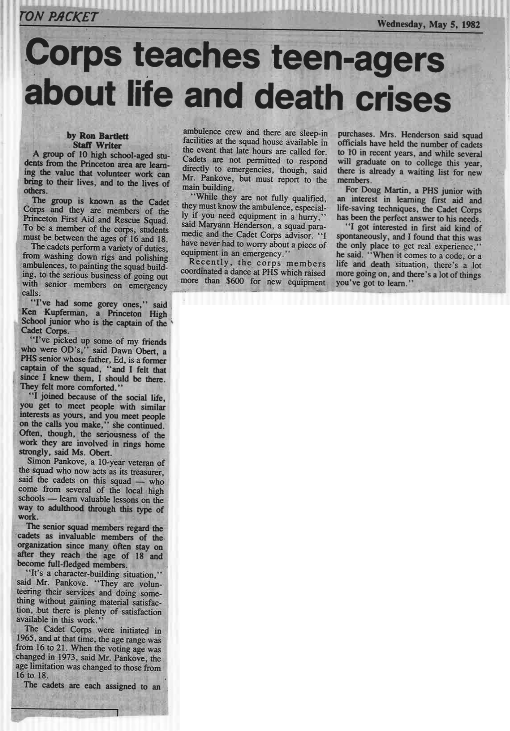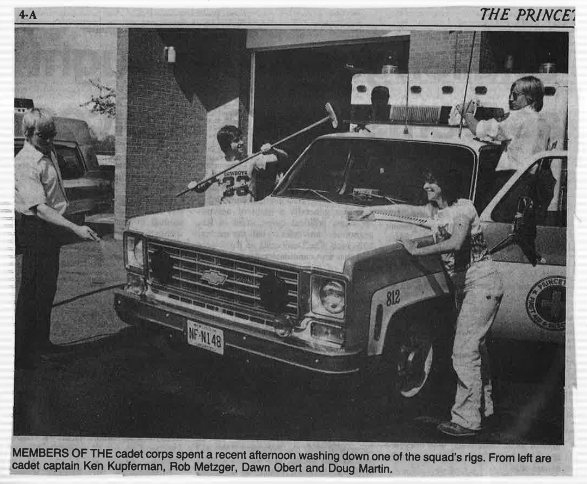
Princeton Packet
5 May 1982
Corps teaches teen-agers about life and death crises
by Ron Bartlett
Staff Writer
A group of 10 high school-aged students from the Princeton area are learning the value that volunteer work can bring to their lives, and to the lives of others.
The group is known as the Cadet Corps and they are members of the Princeton First Aid and Rescue Squad. To be a member of the corps, students must be between the ages of 16 and 18.
The cadets perform a variety of duties, from washing down rigs and polishing ambulances, to painting the squad building, to the serious business of going out with senior members on emergency calls.
‘
“I’ve had some gory ones,” said Ken Kupferman, a Princeton High School junior who is the captain of the Cadet Corps.
“I’ve picked up some of my friends who were OD’s,” said Dawn Obert, a PHS senior whose father, Ed, is a former captain of the squad, “and I felt that since I knew them. I should be there. They felt more comforted.”
“I joined because of the social life, you get to meet people with similar interests as yours, and you meet people on the calls you make,” she continued. Often, though, the seriousness of the work they are involved in rings home strongly, said Ms. Obert.
Simon Pankove, a 10-year veteran of the squad who now acts as its treasurer, said the cadets on this squad — who come from several of the local high schools — learn valuable lessons on the way to adulthood through this type of work.
The senior squad members regard the cadets as invaluable members of the organization since many often stay on after they reach the age of 18 and become hill-fledged members.
“It’s a character-building situation,” said Mr. Pankove. “They are volunteering their services and doing something without gaining material satisfaction, but there is plenty of satisfaction available in this work.”
The Cadet Corps were initiated in 1965, and at that time, the age range was from 16 to 21. When the voting age was changed in 1973, said Mr. Pankove, the age limitation was changed to those from 16 to 18.
The cadets are each assigned to an ambulance crew and there are sleep-in facilities at the squad house available in the event that late hours are called for. Cadets are not permitted to respond directly to emergencies, though, said Mr. Pankove, but must report to the main building.
“While they arc not fully qualified, they must know the ambulance, especially if you need equipment in a hurry.” said Maryann Henderson, a squad paramedic and the Cadet Corps advisor. “I have never had to worry about a piece of equipment in an emergency.”
Recently, the corps members coordinated a dance at PHS which raised more than $600 for new equipment purchases. Mrs. Henderson said squad officials have held the number of cadets to 10 in recent years, and while several will graduate on to college this year, there is already a waiting list for new members.
For Doug Martin, a PHS junior with an interest in learning first aid and life-saving techniques, the Cadet Corps has been the perfect answer to his needs.
“I got interested in first aid kind of spontaneously, and I found that this was the only place to get real experience.” he said. “When it comes to a code, or a life and death situation, there’s a lot more going on, and there’s a lot of things you’ve got to learn.”

MEMBERS OF THE cadet corps spent a recent afternoon washing down one of the squad’s rigs. From the left are cadet captain Ken Kupferman, Rob Metzger, Dawn Obert and Doug Martin.